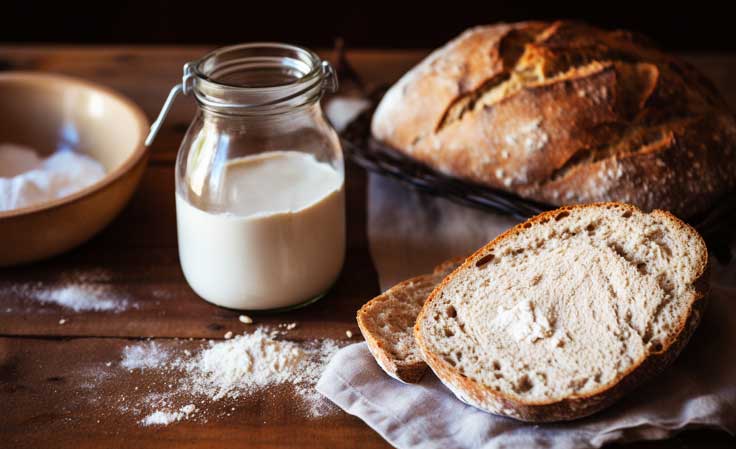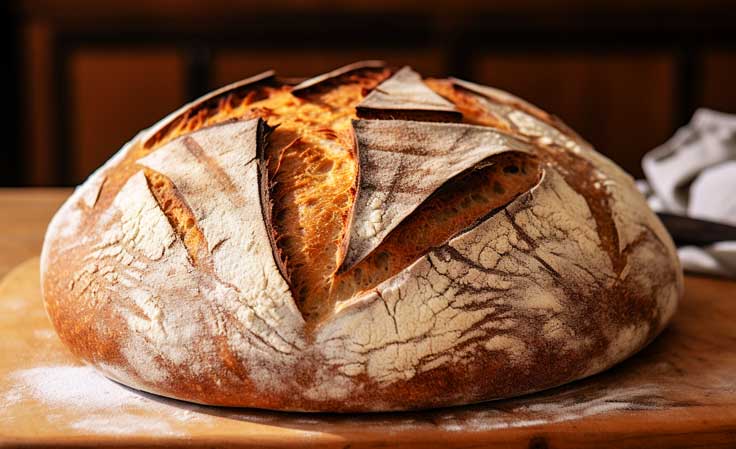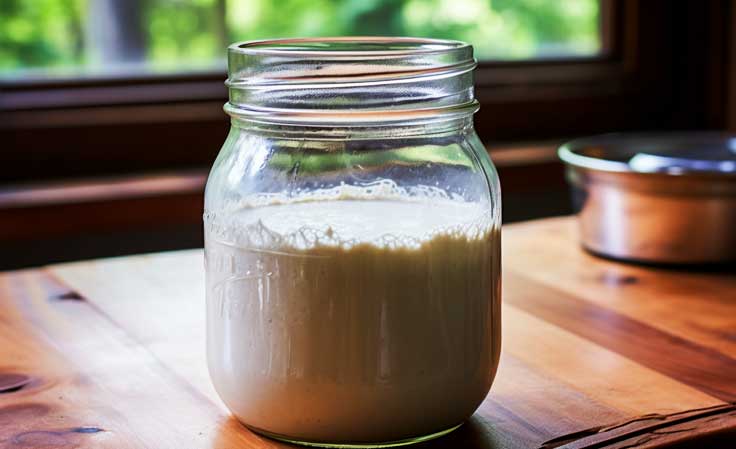Sourdough bread, with its unique flavor and texture, has become a staple in many households. Lately, sourdough baking has been going viral online. I see video after video of people sharing their sourdough creations, and my heart leaps with joy because sourdough truly is an art—a delicious art.
At the heart of this artisanal bread-making process lies a vital ingredient: the sourdough starter. This is where people get intimidated at the process of sourdough. If you want to learn how to make a sourdough starter, go here.
This blog is all about maintaining a sourdough starter and common problems and solutions with your sourdough starter. Keeping a sourdough starter alive and well seems daunting, but I promise it is manageable (and easy!) In this comprehensive blog, we'll delve deep into the art of maintaining a sourdough starter, ensuring your bread baking adventures are not only successful but also filled with the deliciousness that only sourdough can offer.
What is a Sourdough Starter?
Before we jump into the details of maintaining a sourdough starter, let's ensure everyone is on the same page. A sourdough starter is a living mixture of flour and water that captures wild yeast and beneficial bacteria from the environment. This living culture becomes the leavening agent for your bread, imparting that signature tangy flavor and promoting a beautiful rise.
I find it captivating that a sourdough starter is essentially a homemade yeast that you can make from your own kitchen. No more running to the store to grab yeast when you need to make bread, you have your own wild yeast on the counter or in the fridge.
My neighbors traveled the world with their sourdough starter, so their starter has collected wild yeasts and bacteria from different areas of the world. All of which to benefit the gut biome!

Why Maintain a Sourdough Starter?
Maintaining a sourdough starter is essential for several reasons, making it a worthwhile endeavor for any bread enthusiast:
- Consistent Baking: Regular maintenance ensures a reliable rise, leading to consistent, well-textured loaves every time you bake. If you enjoy baking breads, rolls, desserts, or other culinary delights, you will be surprised at how beneficial it is to have a sourdough starter at your disposal.
- Flavor Development: A well-maintained starter develops complex flavors over time, enhancing your bread's taste and aroma. Taste a slice of sourdough bread and then taste a slice of traditional yeast bread. You can TASTE the difference.
- Economical: By maintaining your starter, you eliminate the need to purchase commercial yeast, which can save you money in the long run. Food prices have been rising, you can maintain a sourdough starter for the fraction of the cost of yeast packets.
- Sustainability: With proper care, your sourdough starter can live for years, reducing your reliance on store-bought yeast and promoting sustainability. Some sourdough starters claim to be over 100 years old! Imagine having a sourdough starter as a family heirloom, so cool.
Getting Started
To embark on your sourdough journey, you'll need a few basic supplies:
- A glass or plastic container with a lid for your starter.
- High-quality all-purpose or whole wheat flour.
- Non-chlorinated water (chlorine can inhibit microbial activity).
Daily Feeding Routine
Maintaining your sourdough starter involves a daily feeding routine. Here's how it works:
- Discard: Begin by removing approximately half of your starter. You can save this discarded portion to use in recipes like pancakes, waffles, or brownies. It is important to discard to help maintain a manageable portion of sourdough. If you never discard, your sourdough starter can spiral out of control quickly.
- Feed: Add equal parts of flour and water to the remaining starter. For example, if you have a half cup of starter left in the jar, add half a cup of flour and half a cup of water. Mix it well until it forms a smooth consistency. Sourdough starters can survive if they are fed too much, but not too little.
- Stir and Rest: Stir the mixture thoroughly, cover it loosely with a lid or cloth, and allow it to sit at room temperature.
Signs of a Healthy Starter
A healthy sourdough starter should exhibit the following characteristics:
- Bubbles: It should become bubbly and active within a few hours of feeding. To help the process, you can place your sourdough starter in a warm place. I have noticed if I place mine by the woodstove, it gets extremely active—fast!
- Rise: The starter should double in size after feeding, demonstrating its leavening power.
- Tangy Smell: A pleasant, slightly sour aroma is a sign that the starter is thriving.
Troubleshooting
Encountering issues with your starter is common, especially for beginners. Here are some common problems and solutions:
Slow or No Rising:
Problem: If your sourdough starter isn't rising as expected, it may be due to a weak starter or low temperatures in your kitchen.
Solution: Try feeding your starter more frequently to strengthen it. Ensure it's kept in a warm spot (around 70-75°F or 21-24°C) to encourage fermentation. Patience is key, as starters can take a while to become robust.
Funky Odor:
Problem: An unpleasant or overly strong odor from your starter can be off-putting.
Solution: If it smells like nail polish remover or has an overly acidic aroma, it might be hungry. Increase feeding frequency to maintain a balanced pH. If the odor persists, consider starting fresh with a new starter.
Hooch Formation
Problem: Sometimes, a dark liquid (hooch) forms on top of the starter.
Solution: Hooch is a sign that your starter is hungry and needs to be fed. Pour off the hooch, stir your starter, and feed it immediately. Adjust your feeding routine to prevent this from happening too frequently.
Mold Growth:
Problem: Mold can develop on the surface of a neglected or contaminated starter.
Solution: Discard the moldy portion and any discolored layers beneath. Transfer a small amount of the remaining healthy starter to a clean container and begin regular feedings.
Sticky or Gooey Texture:
Problem: If your starter becomes overly sticky or gooey, it might contain too much water.
Solution: Adjust the hydration by adding more flour during feedings until you achieve a thicker, pancake-batter consistency.
Inconsistent Rising:
Problem: Your starter may rise vigorously one day and barely show any activity the next.
Solution: Maintain a regular feeding schedule and ensure consistent room temperature. Inconsistent feeding intervals can result in unpredictable behavior.
Off-Flavors:
Problem: If your sourdough starter has an unpleasant taste, it might be due to various factors, including the type of flour used or contaminants.
Solution: Experiment with different flours to find one that suits your taste. Ensure your containers and utensils are clean and free from soap residues that can negatively affect your starter's flavor.
Fruit Fly Infestations:
Problem: Fruit flies can be attracted to your starter, especially when it's kept uncovered.
Solution: Always cover your starter with a breathable cloth or a loose-fitting lid. Keep your kitchen clean to prevent fruit flies from being attracted to your baking area. If you have a problem with fruit flies, you can set out jars of vinegar with a cut out coffee filter to capture them and get the problem under wraps.
Overactive Starter:
Problem: If your starter is rising too quickly and collapsing before you can use it, it might be overactive.
Solution: Feed your starter with colder water or store it in a cooler place to slow down fermentation. Reducing the starter's hydration level can also help control its activity.
Sourdough Bread Too Sour:
Problem: If your sourdough bread turns out excessively sour, it may be due to a highly acidic starter.
Solution: Feed your starter more frequently with a lower ratio of old starter to fresh flour and water. Gradually, the acidity should decrease.
Remember, sourdough starters can be resilient and forgiving. Don't be discouraged by these common problems; instead, use them as opportunities to learn and refine your sourdough skills. With patience and adjustments, you can conquer these challenges and create delicious sourdough bread consistently.
Storage and Maintenance
If you need a break from daily maintenance, you can store your sourdough starter in the refrigerator. Here's how:
- Feed: Before refrigerating, feed your starter well.
- Cover: Place your starter in an airtight container or a jar with a loose lid.
- Weekly Feeding: Feed your starter at least once a week while refrigerated. Allow it to come to room temperature before using it in recipes or feeding it again.
For long-term storage, consider freezing a small portion of your starter as a backup. You can also freeze dry your starter to rehydrate and begin feeding again at a later time.
Using Discarded Starter
Don't let the portion you discard during daily feedings go to waste. You can use it to make a variety of recipes, such as pancakes, waffles, crackers, or even to flavor your favorite dishes. I love making desserts like sourdough brownies with my discard.

Benefits of Sourdough Bread
While maintaining a sourdough starter requires dedication, the rewards are well worth it. Here are some benefits of sourdough bread:
- Digestibility: Sourdough fermentation breaks down gluten and phytic acid, potentially making it easier to digest for some people. Surprisingly, some people with celiac can enjoy sourdough bread due to its fermentation that breaks down gluten.
- Improved Nutrient Absorption: The fermentation process can enhance the availability of nutrients like iron and zinc.
- Complex Flavors: Sourdough bread offers a unique, complex flavor profile that is unmatched by commercial bread.
- Longer Shelf Life: Sourdough bread's natural preservatives, including acetic and lactic acids, ethanol, antioxidants, and enzymes, maintain its freshness and shelf life. These elements create an acidic, low-pH environment that deters harmful microorganisms, while antioxidants prevent fat and oil oxidation. Enzymes also contribute to texture preservation. Coupled with reduced water activity, sourdough bread remains flavorful and fresh. Proper storage, like keeping it cool or freezing, extends its longevity.
Sourdough Bread Recipes
Once you have a thriving sourdough starter, you can explore a variety of sourdough bread recipes. From classic sourdough loaves to specialty bread with added ingredients like olives or herbs, the possibilities are endless. Experiment and discover your favorite variations. Truly, maintaining a sourdough starter will change your culinary experience.
Maintaining a sourdough starter is an essential skill for any home baker. It's the heart and soul of sourdough bread, and with daily care and attention, you can enjoy delicious homemade loaves for years to come. Don’t be intimidated by keeping a living pantry staple in your kitchen. So, roll up your sleeves, embrace the art of sourdough, and savor the rewarding journey of maintaining your very own starter. Your taste buds and your family will thank you.
FAQs
Can I use whole wheat flour for my sourdough starter?
Absolutely! Whole wheat flour can enhance the flavor of your starter and provide added nutrients.
How long does it take to establish a new sourdough starter?
It typically takes about 5-7 days for a new starter to become active and ready for baking.
Can I use tap water for feeding my starter?
It's best to use non-chlorinated water, as chlorine can inhibit the growth of beneficial microorganisms. You can use filtered or dechlorinated water. If you are on city tap water, you will definitely need a water filter to get the chlorine out.
Can I revive a neglected starter?
Yes, neglected starters can often be revived with regular feedings and patience. I neglected mine once for over a month and was able to revive it with a regular feeding schedule.
How do I know when my starter is ready to be used in bread recipes?
Your starter is ready when it consistently doubles in size within 4-6 hours of feeding and has a strong, tangy aroma.

